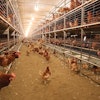Forecasts for Russian pig production are expected to increase in 2013 and pork imports also are up slightly as improved market access is likely to lead to more pork consumption, according to a report from the FAS-USDA.
Rosstat (Russian Federal State Statistics Service) reports 2013 pig inventories are approximately 18.8 million head, a noteworthy increase over past years. The increase in pig stocks is attributed to reduced backyard production (nearly 10 percent by volume) as a result of outbreaks of African Swine Fever and reduced competitiveness of informal producers compared with modernized agricultural establishments.
Efficient pig production has led to an increase in the number of domestic swine, and, given their improved production practices, an increased pig herd. With the increase in the number of domestically produced live pigs, and the ongoing trade restrictions on live swine imports from the European Union due to outbreaks of the Schmallenburg virus, FAS/Moscow has revised downward its 2013 forecast for swine imports.
However, given the increase in domestic pig stocks, coupled with burgeoning feed costs as noted above, Russian domestic pork production is expected to appreciably increase in 2013. An increase in pork imports in 2013 is also anticipated, as compared to previous estimates, because of Russia’s WTO commitments – namely a TRQ with favorable import duties and, as is the case for beef, continued modification of existing sanitary regulations.
FAS/Moscow forecasts 2013 beginning stocks of pigs to increase by 8 percent over past estimates as result of an increase in year-end Rosstat inventory statistics. Backyard pig production has been declining in Russia for several years, but inventories at these farms significantly declined in 2012 (falling by nearly 10 percent, by volume).

















